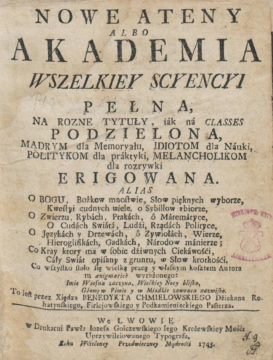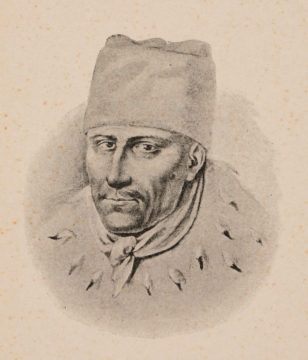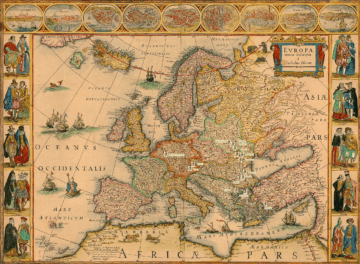by Rafaël Newman
All my life I’ve been fascinated by the systems of mutual connections and influences of which we are generally unaware, but which we discover by chance, as surprising coincidences or convergences of fate, all those bridges, nuts, bolts, welded joints and connectors… —Olga Tokarczuk, Nobel Lecture, December 7, 2019

When I was quite young I had a dream, or fantasy, of a Purple Book: a richly satisfying, totally illuminating, all-encompassing volume that would replace all others and provide endless comfort and sustenance. There were to be numerous candidates for this status in my subsequent “real life”, including novels like Watership Down, Ulysses, Bouvard et Pécuchet and Austerlitz, as well as books of towering historical survey or “grand theory” such as Mary Beard’s SPQR, Yuval Harari’s Sapiens, and Tony Judt’s Postwar. The Purple Book remained for a long time a symbol of an elusive fulfilment, now and then briefly glimpsed, always fleeting; until the more pressing cares and more vivid, if still ephemeral, satisfactions of adult life drove it into retreat.
That such total understanding and ultimate satisfaction should have been represented in my imaginary by a printed object has a fairly straightforward aetiology, given the academic culture into which I was born. The purpleness of that dream book, for its part, was multiply motivated: by my youthful apprehension of the color’s sacerdotal significance; by a naïve, pre-adolescent suspicion of its intoxicating powers of erotic evocation (I had once heard the father of a grade-school colleague refer to crème de cassis as the “sexiest” liqueur he had ever tasted); and, perhaps most profoundly because least patently, by its subterranean association with Jewishness, that most elusive, and thus most attractive, element of my own personal cultural makeup, which would remain a tantalizing chimera during much of my youth and young adulthood. For not only was the velvet bag enclosing my Polish Jewish grandfather’s prized Crown Royal rye whisky, famously manufactured by the Bronfmans, Canada’s preeminent Jewish dynasty, a dusky papal hue; not only was the membership of the notorious Purple Gang, which had been among the mobsters smuggling the Bronfmans’ products into Prohibition-era America, and which rated a name-check in Elvis Presley’s “Jailhouse Rock”, predominantly Jewish; but the very description of the Jews as “the People of the Book” lends itself, by oneiric transposition (people/purple), to a connection with the color. (Extra weight may have been granted the association by my Jewish father’s invention, in my infancy, of a game he called “the Purple Terror”, which involved propping me up against the back of the sofa and then allowing me to collapse, riotously, into the cushions, thence to be “rescued” by my deliciously horrified mother: a ludic enactment of the illusory promise of upright paternal support giving way to a vertiginous subsidence into the amorphic maternal.)
 All of these elements – the hieratic; the erotic; the criminal; the intoxicating; the bridging of cultural and sexual divides; but most distinctly the Jewish – converge in Olga Tokarczuk’s gigantic Księgi Jakubowe, “The Books of Jacob”, published in Polish in 2014 and due out in English, thanks to her admirable, Man Booker International Prize co-winning translator Jennifer Croft, in March of 2021. The full title of Tokarczuk’s novel, her ninth and the product of seven years of historical research, primarily into 18th-century Central European culture and politics, is as ample as the over 1,000-page volume itself, taking up the entirety of the cover in sprawling, Baroque fashion: “The Books of Jacob, or the Great Journey across Seven Frontiers, Five Languages and Three Great Religions, Not Counting Several Minor Ones: Narrated by the Dead, Their Story Being Completed by the Author According to the Method of Conjecture, Expressed in Several Books, but also Assisted by the Imagination, Which Is Humanity’s Greatest Natural Gift: A Record for the Wise, A Reflection for My Compatriots, An Instruction for Laypersons, Entertainment for Melancholics.”
All of these elements – the hieratic; the erotic; the criminal; the intoxicating; the bridging of cultural and sexual divides; but most distinctly the Jewish – converge in Olga Tokarczuk’s gigantic Księgi Jakubowe, “The Books of Jacob”, published in Polish in 2014 and due out in English, thanks to her admirable, Man Booker International Prize co-winning translator Jennifer Croft, in March of 2021. The full title of Tokarczuk’s novel, her ninth and the product of seven years of historical research, primarily into 18th-century Central European culture and politics, is as ample as the over 1,000-page volume itself, taking up the entirety of the cover in sprawling, Baroque fashion: “The Books of Jacob, or the Great Journey across Seven Frontiers, Five Languages and Three Great Religions, Not Counting Several Minor Ones: Narrated by the Dead, Their Story Being Completed by the Author According to the Method of Conjecture, Expressed in Several Books, but also Assisted by the Imagination, Which Is Humanity’s Greatest Natural Gift: A Record for the Wise, A Reflection for My Compatriots, An Instruction for Laypersons, Entertainment for Melancholics.”
Tokarczuk’s title, as Stephen Rojcewicz points out, whose rendering from the Polish I reprint here, since the full English title is not yet available, is an homage to her novel’s deuteragonist: for alongside the “Jacob” of the title – Jacob Frank, born Ja’akow Josef ben Jehuda Lejb, or Jakub Lejbowicz (c. 1726-1791), the self-proclaimed 18th-century Judeo-Catholic Messiah, whose peregrinations the novel chiefly recounts – Tokarczuk also gives us the vicissitudes of one particular “Book” (among several others of importance to her account). That work is Nowe Ateny, or The New Athens, by Benedykt Chmielowski (1700-1763), whose full title, again in Rojcewicz’s rendering, is The New Athens, or the Academy Full of All Science, Divided into Subjects and Classes, A Record for the Wise, Instruction for the Uneducated, A Practicum for Politicians, a Foundation of Entertainment for Melancholics. First published in Lwów (present-day Lviv) in 1745/1746, The New Athens was the first Polish-language encyclopedia, a compendium of fragments and quotations from a wide variety of sources, including pagan and Jewish, with annotation, much of it in Latin, frequently (and notoriously) betraying a pre-Enlightenment belief in superstition and legend.
 Benedykt Chmielowski also appears in Tokarczuk’s Bieguni (2007), translated by Jennifer Croft as Flights (2017), where he is presented, and cited, as a historical figure, in the narrator’s first-person voice, with the same admiration for compilers of reference works – including, explicitly, Wikipedia – later expressed in Tokarczuk’s Nobel Lecture:
Benedykt Chmielowski also appears in Tokarczuk’s Bieguni (2007), translated by Jennifer Croft as Flights (2017), where he is presented, and cited, as a historical figure, in the narrator’s first-person voice, with the same admiration for compilers of reference works – including, explicitly, Wikipedia – later expressed in Tokarczuk’s Nobel Lecture:
In my own travels I have remained faithful to two books which I refer to above all others, in spite of their age, because they were written with real passion, and a genuine desire to portray the world. The first was written in Poland in the early eighteenth century. Around the same time, other essays written in the Enlightenment West may have been more successful, but none possesses as much charm as this one. Its author was a Catholic priest named Benedykt Chmielowski, who hailed from Volhynia (a region now shared by Poland, Ukraine, and Belarus). He was a kind of Joesphus cloaked in a provincial fog, a Herodotus on the outermost outskirts of the world. I suspect he might have suffered from the same syndrome I did, although unlike me, he never actually left his home. (Flights, tr. J. Croft, p. 70)
In its armchair fashion, Chmielowski’s research for a second edition of his encyclopedia, which forms a secondary strand of the narrative in The Books of Jacob, and in particular Chmielowski’s quest for works of Jewish mysticism, parallels Jacob Frank’s journey, from his birth in the Podolian Voivodeship of the Kingdom of Poland in or around 1726, through European and Asian outposts of the Ottoman Empire, imprisonment in Poland, residence in Moravia and Vienna, to his ennoblement as head of a sect in Offenbach, where he died in 1791. Frank’s lifelong project was to establish himself in a messianic tradition within Judaism, as the Ashkenazi successor to Sabbatai Zevi (1626–c. 1676), the Sephardic Kabbalist from Smyrna. As Frank traverses the Ottoman, Polish-Lithuanian, and Holy Roman Empires in the century following Sabbatai Zevi’s, amid a welter of languages, faiths, and customs, at times allied, occasionally at war with one another, he seeks recognition as the reincarnation of the biblical patriarch Jacob while also striving for transcendence, through redemptive liturgical and sexual transgression, of the constraints of Talmudic Judaism.
 Here is another of the “Books” in Tokarczuk’s dramaturgy: the Talmud, Frank’s great foe and the object of his at times murderous wrath. If not actually illiterate, Frank did not himself set out his theology in writing, and relied on others to record his thoughts and pursue his correspondence (chief among them, charmingly in Tokarczuk’s account, his countryman and disciple Nachman and the renegade Polish nobleman Moliwda*); but the negative source of much of Frank’s sectarian fervor was indeed a written text, the Talmud, the voluminous compendium of rabbinic commentary and exposition of the Torah and Jewish law that has served as a guide to Jews in the diaspora. Frank’s rejection of the Talmud in favor of the Zohar, the Kabbalists’ sacred text, and his promotion of the shekhinah, the feminine aspect of Jewish divinity, and thus of a multipart godhead not inimical to the Christian trinity, led to his being cynically championed by Polish Catholic authorities in their bid to repress the traditional Jewish community; in the event, thousands of copies of the Talmud were burned throughout Poland, and Frank himself may have helped to promote the blood libel against his fellow Jews (while demonstrating his perverse respect for the shekhinah by mandating wife-swapping but arrogating sole polygamist’s rights to himself). For its part, Poland’s Jewish community imposed a religious ban or cherem on Frank, who was eventually imprisoned by Polish authorities on charges of heresy when his main clerical advocate died and suspicions arose concerning the sincerity of his sect’s wish to convert to Christianity.
Here is another of the “Books” in Tokarczuk’s dramaturgy: the Talmud, Frank’s great foe and the object of his at times murderous wrath. If not actually illiterate, Frank did not himself set out his theology in writing, and relied on others to record his thoughts and pursue his correspondence (chief among them, charmingly in Tokarczuk’s account, his countryman and disciple Nachman and the renegade Polish nobleman Moliwda*); but the negative source of much of Frank’s sectarian fervor was indeed a written text, the Talmud, the voluminous compendium of rabbinic commentary and exposition of the Torah and Jewish law that has served as a guide to Jews in the diaspora. Frank’s rejection of the Talmud in favor of the Zohar, the Kabbalists’ sacred text, and his promotion of the shekhinah, the feminine aspect of Jewish divinity, and thus of a multipart godhead not inimical to the Christian trinity, led to his being cynically championed by Polish Catholic authorities in their bid to repress the traditional Jewish community; in the event, thousands of copies of the Talmud were burned throughout Poland, and Frank himself may have helped to promote the blood libel against his fellow Jews (while demonstrating his perverse respect for the shekhinah by mandating wife-swapping but arrogating sole polygamist’s rights to himself). For its part, Poland’s Jewish community imposed a religious ban or cherem on Frank, who was eventually imprisoned by Polish authorities on charges of heresy when his main clerical advocate died and suspicions arose concerning the sincerity of his sect’s wish to convert to Christianity.
One hundred years before Frank’s expulsion from the Jewish community of Poland, Baruch Spinoza (1632-1677), a Portuguese-Dutch Sephardic contemporary of Sabbatai Zevi’s, was excommunicated by Amsterdam’s Jewish community, subject to a writ of cherem for his “evil opinions”. Like Frank a century later, Spinoza had rejected traditional Judaism, its metaphysics and its laws; unlike his Ashkenazi counterpart in apostasy, however, he seems not to have found it necessary to convert to any other religion in order to express his faith in the truth, and its rational interpretation, and his quest for proof of the divine connectedness of all things. “So how is the relationship among God, the absolute, and finite things to be construed,” asks Leszek Kołakowski, in an essay on the questions Spinoza poses. “They are not parts of God, nor are they independent; and yet God cannot be grasped by reference to these things, but rather only through Himself. This is a peculiar construction and it becomes clear from Spinoza’s letters that he was aware of his failure to answer this central question: How is the being of things to be explained in relation to God?”
Alongside the two great figures or strains of Tokarczuk’s work – Jacob Frank, and the Books that shaped him – there is a third, a strand of narrative that takes up this Spinozan belief in the comprehensive, transcendent nexus of nature. In the character of Yenta, who may be Frank’s grandmother – introduced in a brief prologue as she swallows a slip of paper, an amulet inscribed with a magical incantation designed to prevent her imminent death, and the resulting inconvenient interruption of the family wedding at which she has been taken ill; and who consequently lives on, undead but all-seeing, throughout the novel and into perpetuity – Tokarczuk fashions an omniscient consciousness that is a philosophical correlative to the shekhinah. As she gazes down serenely, from her vantage point beyond death, on the doings of her kin and extended family, pursuing her cosmic travels in both physical and temporal space, Yenta apprehends the interconnection of all things, events, and people:
And yet this death sets a certain train of events in motion, which must be trusted, since nothing else is available to us. And if one looks closely, as Yenta is now able to see, one notices all the little bridges, paths, screws and hinges and all the tiny instruments that link up those individual, unrepeatable events into a whole. They are the world’s true adhesive, since they apply this or that utterance to the arrayed happenings; rhythmically repeat a gesture or a facial expression, often in a new environment; bring the same objects, or the same people, into contact with one another over and over again; assemble the ideas of things that are by nature foreign to each other into apparent sequences of events.
Like Yenta, Olga Tokarczuk has assembled “the ideas of things that are by nature foreign to each other”: the various peoples, languages, cultures, and religions that have made up the “sequence of events” that has come to be known as her country. “In Poland,” however, as Ruth Franklin has noted, “a narrative of history that embraces fragmentation, diversity, and intermingling is unavoidably political, disrupting a long-standing mythology of the country as a homogeneous Catholic nation.” Tokarczuk imaginatively reconstructs Polish history to include instances of parochialism, bigotry, complicity with genocide (the novel stretches deep into the period of the Shoah), and homegrown pogroms, episodes conventionally elided by “patriots”; and this has won her abuse and death threats at home. And yet Tokarczuk is at the same time true, in her way, to a certain strain of Polish culture, what Gesine Schwan, writing about the émigré Polish philosopher Kołakowski, has identified as a peculiar mixture of the nationalist and the cosmopolitan; of the rationalist and the mythological; of the skeptical and the metaphysical.
 In a 2016 interview, Olga Tokarczuk recalls reading about her country in a book – an encyclopedia, naturally – while visiting a library in England. She was bemused to discover the following sentence included in the entry: “Poland is a country which pops up on maps of Europe from time to time.” At first she resisted the characterization, since, as she says, she had always believed that hers was a country that existed continuously; but then she came to see that, despite its venerable history, resolutely European culture, and marvelously plastic language, Poland is “a place where you rarely feel safe in an existential sense”, and which constantly requires narrating afresh. In works like Primeval and Other Times, her alternative history of Poland in the 20th century; Drive Your Plow Over the Bones of the Dead, a diatribe against the allied forces of paternalism and anthropocentric chauvinism in rural Poland; and, most remarkably, in The Books of Jacob, Tokarczuk does just that: she narrates her country afresh, by marrying encyclopedic knowledge with a mythopoetical voice.
In a 2016 interview, Olga Tokarczuk recalls reading about her country in a book – an encyclopedia, naturally – while visiting a library in England. She was bemused to discover the following sentence included in the entry: “Poland is a country which pops up on maps of Europe from time to time.” At first she resisted the characterization, since, as she says, she had always believed that hers was a country that existed continuously; but then she came to see that, despite its venerable history, resolutely European culture, and marvelously plastic language, Poland is “a place where you rarely feel safe in an existential sense”, and which constantly requires narrating afresh. In works like Primeval and Other Times, her alternative history of Poland in the 20th century; Drive Your Plow Over the Bones of the Dead, a diatribe against the allied forces of paternalism and anthropocentric chauvinism in rural Poland; and, most remarkably, in The Books of Jacob, Tokarczuk does just that: she narrates her country afresh, by marrying encyclopedic knowledge with a mythopoetical voice.
I cannot wait for her next Purple Book.
*Among the great pleasures of Tokarczuk’s novel are its epistolary components, especially the (imaginary) correspondence between Chmielowski and the poet Elżbieta Drużbacka, rendered, in the German translation I read, in a marvelously ornate 18th-century diction. (The exceptional German team of translators, Lisa Palmes und Lothar Quinkenstein, have documented their painstaking research in a journal, available online.) It will be interesting to compare Croft’s renditions in her forthcoming English translation; if her version of the letters of Josefine Soliman, who petitions the Emperor of Austria for the return of the embalmed body of her African father, in Flights is any indication, Croft’s Nachman, Moliwda, Chmielowski, and Drużbacka will be equally delightful.
